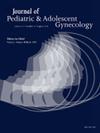7. A Unique Presentation of Primary Amenorrhea: Bilateral Ovarian Hyperthecosis in an Adolescent with Bardet-Biedl Syndrome
IF 1.7
4区 医学
Q3 OBSTETRICS & GYNECOLOGY
引用次数: 0
Abstract
Background
Ovarian hyperthecosis (OH) is a cause of hyperandrogenism (HA) primarily occurring in postmenopausal women; extensive literature review shows no cases of OH occurring in a premenarchal patient. Bardet-Biedel Syndrome (BBS) is a genetic disorder associated with a constellation of symptoms including obesity and metabolic disorders; there has been one other documented case of BBS associated with OH occurring in a 40-year-old. We present a case of OH causing primary amenorrhea and virilization in a teen with BBS.
Case
IRB exempt status was confirmed through our IRB process. A 15-year-old female with history of BBS presented with primary amenorrhea and HA. Exam notable for Tanner stage IV breast development, clitoromegaly, moderate acne, and hirsutism. Laboratory workup notable for significantly elevated total testosterone (TT) of 394, confirmed on repeat. No identifiable source of exogenous testosterone. Imaging studies with normal post-pubertal uterus; negative for ovarian or adrenal masses. Congenital adrenal hyperplasia and genetic testing were normal. Negative progestin challenge. Gonadal vein sampling performed, with right ovarian vein TT 4780 and all other sites TT 500-600, raising suspicion for unilateral OH. Due to medical co-morbidities, most medication options were contraindicated. Patient underwent laparoscopic right oophorectomy; OH confirmed on pathology. Following oophorectomy, TT levels initially dropped but then rose again and remained persistently elevated over 1 year. After extensive counseling and shared decision-making with the patient and family, decision was made to proceed with left oophorectomy, and pathology confirmed OH of the left ovary. IUD was placed during surgery for endometrial protection; she was started on estradiol patches for hormone replacement. FT and TT down trended to normal levels, and hirsutism and acne improved; she also reported significant improvement in her mood. Monitoring of TT levels is ongoing.
Comments
Identifying the etiology for HA in young patients can be difficult; PCOS is often used as a catch-all diagnosis, especially in the setting of obesity and other metabolic disorders. Our case highlights a rare cause of HA, which easily could have been mistaken for severe PCOS; in addition, treatment was particularly difficult given her co-morbidities which precluded most medication management options. We hope this case can offer an example of extended work up of HA, especially when lab values and clinical manifestations do not align, as well as one management option in a medically complex patient when standard guidelines cannot be followed.
7. 原发性闭经的独特表现:青春期Bardet-Biedl综合征双侧卵巢囊肿
背景:卵巢卵巢囊肿(OH)是一种主要发生在绝经后妇女的高雄激素症(HA)的原因;广泛的文献回顾显示,没有病例OH发生在月经前期的病人。Bardet-Biedel综合征(BBS)是一种与一系列症状相关的遗传性疾病,包括肥胖和代谢紊乱;另有一例BBS与OH相关的病例,发生在一名40岁的患者身上。我们提出一个病例OH引起原发性闭经和男性化的青少年与BBS。个案豁免状态通过我们的IRB流程确认。15岁女性,有BBS病史,主要表现为闭经和HA。Tanner IV期乳房发育、阴蒂肿大、中度痤疮和多毛。实验室检查发现总睾酮(TT)明显升高394,重复检查证实。外源性睾酮来源不明。正常青春期后子宫的影像学研究;卵巢或肾上腺肿块阴性。先天性肾上腺增生,基因检测正常。黄体酮阴性。进行了性腺静脉取样,右卵巢静脉TT 4780和所有其他部位TT 500-600,引起单侧OH的怀疑。由于医疗合并症,大多数药物选择是禁忌症。患者行腹腔镜右卵巢切除术;病理证实。卵巢切除术后,TT水平开始下降,但随后又上升,并在1年内持续升高。经过广泛的咨询和与患者及家属共同决策,决定进行左卵巢切除术,病理证实左卵巢OH。术中放置宫内节育器保护子宫内膜;她开始使用雌二醇贴片来替代激素。FT和TT趋于正常水平,多毛和痤疮有所改善;她还报告说她的情绪有了显著改善。正在监测TT水平。确定年轻患者HA的病因可能很困难;多囊卵巢综合征通常被用作全面诊断,特别是在肥胖和其他代谢紊乱的情况下。我们的病例强调了一种罕见的HA病因,它很容易被误认为是严重的PCOS;此外,考虑到她的合并症,治疗特别困难,这使大多数药物管理选择无法进行。我们希望这个病例可以提供一个扩展HA工作的例子,特别是当实验室值和临床表现不一致时,以及在无法遵循标准指南的医疗复杂患者中的一种管理选择。
本文章由计算机程序翻译,如有差异,请以英文原文为准。
求助全文
约1分钟内获得全文
求助全文
来源期刊
CiteScore
3.90
自引率
11.10%
发文量
251
审稿时长
57 days
期刊介绍:
Journal of Pediatric and Adolescent Gynecology includes all aspects of clinical and basic science research in pediatric and adolescent gynecology. The Journal draws on expertise from a variety of disciplines including pediatrics, obstetrics and gynecology, reproduction and gynecology, reproductive and pediatric endocrinology, genetics, and molecular biology.
The Journal of Pediatric and Adolescent Gynecology features original studies, review articles, book and literature reviews, letters to the editor, and communications in brief. It is an essential resource for the libraries of OB/GYN specialists, as well as pediatricians and primary care physicians.

 求助内容:
求助内容: 应助结果提醒方式:
应助结果提醒方式:


